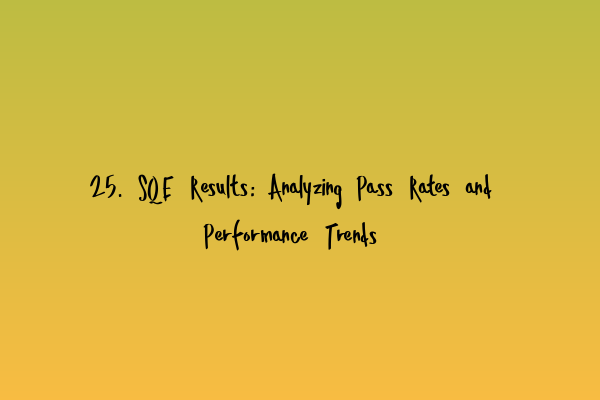25. SQE Results: Analyzing Pass Rates and Performance Trends
As the Solicitors Qualifying Examination (SQE) becomes the new standard for aspiring solicitors, it is natural to analyze the pass rates and performance trends to understand the overall landscape of this challenging exam. In this article, we will delve into the SQE results and provide valuable insights into the patterns that emerge.
Before we dive into the details, it is worth mentioning that preparing for the SQE requires dedication, a comprehensive study plan, and access to effective resources such as interactive mock tests and sample papers. If you haven’t already, we recommend reading our related articles on:
- Conquer the Multiple Choice Questions (MCQ) in SQE1
- Interactive mock tests for SQE: Enhancing engagement and learning</li>
- SQE Sample Papers: Practice for Exam Success
- Focus Areas in SQE1 and SQE2: Mastering Key Concepts
- Adjusting Your SQE Strategy Based on Mock Performance
Pass Rates
Pass rates are an essential metric for evaluating the difficulty of an examination and the proficiency of candidates. The SQE has witnessed varying pass rates across different components and sittings. Understanding these pass rates can help candidates set realistic expectations and adjust their study strategies accordingly.
In recent years, the SQE1 pass rates have been relatively high, ranging from 70-80%. This indicates a relatively manageable level of difficulty for candidates. However, it is essential to note that the pass rates may vary based on the specific sitting and the cohort attempting the exam.
On the other hand, the SQE2 pass rates tend to be lower, ranging from 60-70%. This component focuses on practical legal skills and requires candidates to demonstrate their ability to apply legal knowledge in real-world scenarios. The relatively lower pass rates in SQE2 suggest the need for more rigorous preparation in this area.
Analyzing pass rates over time can provide additional insights. It is common for the first sitting of a new examination to have lower pass rates as candidates and preparation providers adjust to the format and expectations. As the SQE progresses and candidates become more familiar with its demands, pass rates tend to increase. Therefore, it is crucial for candidates to adapt their strategies based on the feedback and analysis of previous sittings.
Performance Trends
Identifying performance trends can help candidates develop a solid understanding of the areas in which they excel and the aspects they need to improve. Analyzing the performance data can also guide the creation of effective study plans and the allocation of study time.
One noticeable trend in SQE1 is the higher performance in multiple-choice questions (MCQ) compared to the written tasks. MCQs are generally approached differently, empowering candidates to utilize effective test-taking strategies. It is vital for candidates to invest time in mastering the techniques to succeed in this component.
On the other hand, SQE2 performance trends indicate that written tasks require meticulous attention to detail and careful analysis. Candidates should focus on developing their legal writing skills and ensuring their responses are concise, well-structured, and address the specific requirements of the task.
Conclusion
Examining the SQE pass rates and performance trends provides invaluable insights into the benchmarks set by previous candidates and the areas that require dedicated preparation. Aspiring solicitors should thoroughly analyze the data, adapt their study strategies accordingly, and utilize resources such as interactive mock tests and sample papers to maximize their chances of success.
For a comprehensive guide on the different components of the SQE and how to excel in each, we recommend exploring our related articles mentioned above:
- Conquer the Multiple Choice Questions (MCQ) in SQE1
- Interactive mock tests for SQE: Enhancing engagement and learning
- SQE Sample Papers: Practice for Exam Success
- Focus Areas in SQE1 and SQE2: Mastering Key Concepts
- Adjusting Your SQE Strategy Based on Mock Performance
By leveraging these resources and insights, you can enhance your SQE preparation and increase your chances of achieving success in this important examination.
